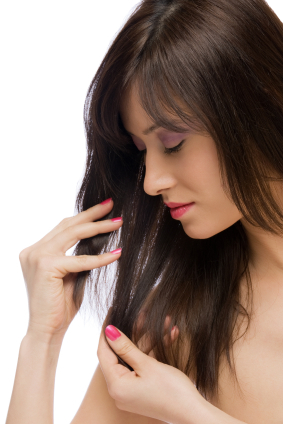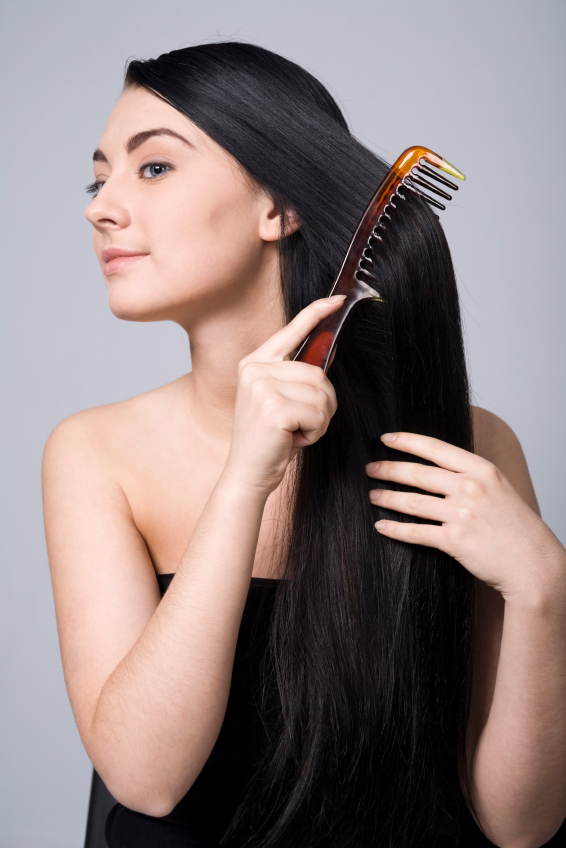This is part 4 of a 4 part series on Growing your hair and preventing damage. For further reading check out:
Part 1 Part 2 Part 3

Use of blunt scissors to cut/trim the hair
Use a sharp pair of scissors when trimming your hair. Choose a pair that is for the hair and use them for hair cutting only. Blunt scissors will only cut a jagged and rough edge on the end of the hair making the ends susceptible to damage. Sharp scissors will cut cleaner.
Not removing split ends/damage
Split ends cause the hair to become very tangle-y, which in time causes more splits, more tangles and more damage. Cut off split ends (search and destroy) with a sharp pair of hair cutting scissors that are not, or have been used for anything else.
Use of heat tools
No surprise there! Overuse of heating tools such as straighteners, curlers, crimpers, and hair dryers can dehydrate your hair by boiling the moisture within making it feel very dry, indeed. Over time, the hair gets dryer, and dryer, which will eventually lead to splitting and breaking of the hair strand. More breakage causes more splits. If you must blow dry your hair, use the cool setting and keep up with deep moisture treatments; your hair will thank you in the end! Another thing: Those heat protectant sprays? They don’t really protect the hair. Basically, these heat protectant sprays are loaded with silicones that actually hide the damage caused by heat appliances. Once the hair has been clarified and the silicones removed, the damage is likely to appear. It is best to rarely use or avoid heat styling tools.
There are plenty of methods for getting straight, wavy or curly hair. Check out hair wrapping (to achieve straighter hair), rag curls (to achieve curly hair). For waves, braid waves work wonderfully. For a crimped style, if by chance you really feel like re-living the 80s, make small braids all over and sleep in them over night.
Repeated use of chemicals (perms/chemical relaxers)
Chemical relaxers and perms work by changing the basic structure of the hair by entering the hair shaft by opening the cuticles and re-arranging the bonds within the hair which loosen or creates the curl structure. Since relaxers and perms have a high pH, they are incredibly damaging to the hair and skin.
A microscopic image of a hair strand showing the damage caused by repeated perms and this one shows relaxer damage. Hair in this state is incredibly brittle and dry and will break at ease. Compare those pictures to a strand of healthy hair. There’s a shocking difference, isn’t there? As you can see, there is a vast difference between healthy adult hair and processed hair.
A simple solution would be to stop using these chemicals on the hair, however, one can always do root touch ups and apply many protein and moisture treatments to help the hair. Protein and moisture are essential for those that frequently use relaxers and perms.
Sleeping with hair loose
Leaving the hair loose, especially if you toss and turn, sleep next to someone that does (or share the bed with pets), can wreak hair havoc for the morning! Not too many people do have the time to de-tangle their hair in the morning which is why braiding/bunning or wearing a scarf/sleep cap can be very beneficial and helpful! Silk/polyester pillowcases are fantastic for the hair and skin as the surface is smooth allowing the hair to glide across instead of rub against fiber. Even though polyester satin may be cheaper, the silk is a much superior option as it is a natural fiber and is a breathable material. Most long hairs just braid their hair and flip it over the pillow, or just flip their hair over a pillow, which seems to work well for them.
Damaged hair? What else can I do?
So you want to start treating your hair better. Remember, that most forms of damage cannot technically be reversed and have to gradually be cut off as healthy hair grows in. Try oiling your ends after spritzing them with water to keep them moisturised and happy. Do assess the condition of your hair. Taking care of your hair is supposed to be a fulfilling and happy journey. Figure out what your hair needs to keep both you and your hair happy. Cassia and henna can help a great deal with rehabilitating the hair.
We hope you’ve enjoyed reading this 4 part series on growing hair and preventing damage!


















If I have damaged hair, would henna help improve it?
Hi Cocoa!
Absolutely! Both henna and cassia will help.
I have dark brown hair. Can i use cassia with my henna too?
Yes, you can, but keep in mind that the colour of the henna with cassia can produce light coppery gingery shimmer over your dark brown hair depending on the ratios of cassia-to-henna as cassia does dilute the henna.
Thank you Vanessa.
My hair dresser says that coloring my hair with Henna will damage it, dry it out and when the Henna color starts wearing off, it will take the cuticle off my own hair and this is why you have to keep coloring with henna if you want your hair to look good. Is this true?
Hello Barbara
Thank you for your message at Henna Blog Spot! There’s a misconception amongst hair dressers as they are trained with chemical products and the big companies push these type of products over natural and organic products. They don’t have much experience with henna. In some ways they’re right about the henna products as some henna products can cause damage but our products at Henna Sooq (www.hennasooq.com) we have the right products for maintaining a natural hair color and healthy, radiant hair. We also have products that are perfect for moisturizing. I hope this helps.
is henna damage the hair. if use once in a week. some are saying hair becomes dry and hair fll wil happen.
Real henna won’t damage your hair. There are all of fake or poor quality hennas out there that can and will mess uo your hair. Again, real henna (the right brand and quality) won’t that.
It will add color and help your hair remain healthy. I leave mine in overnight. I use henna mixed with indigo leaves and shea butter, lol.
That’s awesome Jordan! Love your recipe too. It’s really interesting though and true that sometimes even real henna, organic henna, 100% henna, can still sometimes be damaging to some hair types. This is what this article focuses on. As your results may not be the same result for someone else. We want every hair type and person to be able to use henna and it’s about tweaking the recipe to make it work for them. This article helps those who use henna and it caused breakage or an usse and to help them stick with henna based on recommendations.